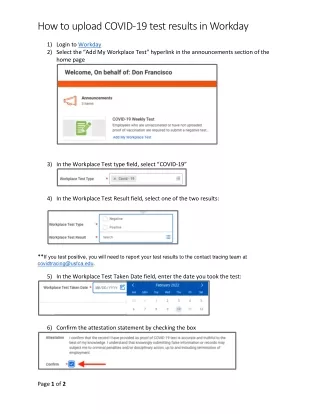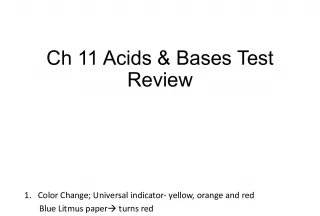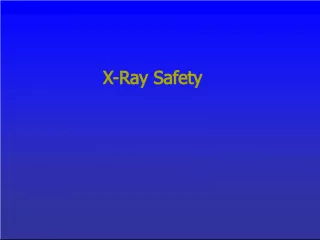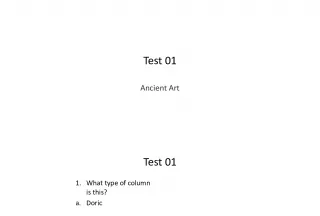Understanding Your CBC Lab Test Results


This article explains the significance of a Complete Blood Count (CBC) test and what the different cell types and numbers mean for a person's health. It covers topics such as red blood cells, white blood cells, platelets, anemia, hemolysis, and polycythemia.
- Uploaded on | 8 Views
-
 paulprice
paulprice
About Understanding Your CBC Lab Test Results
PowerPoint presentation about 'Understanding Your CBC Lab Test Results'. This presentation describes the topic on This article explains the significance of a Complete Blood Count (CBC) test and what the different cell types and numbers mean for a person's health. It covers topics such as red blood cells, white blood cells, platelets, anemia, hemolysis, and polycythemia.. The key topics included in this slideshow are CBC, complete blood count, red blood cells, white blood cells, platelets,. Download this presentation absolutely free.
Presentation Transcript
1. WHAT DO THOSE LAB TESTS MEAN?
2. CBC (COMPLETE BLOOD COUNT) measures the number of cells of different types circulating in the bloodstream three major types of blood cells in circulation; red blood cells (RBC), white blood cells (WBC), and platelets. Red blood cells are produced in the bone marrow Pick up oxygen brought into body by the lungs Bring that oxygen to cells Live in blood stream for about 100 days Old rbcs removed from blood stream by spleen and liver Numbers are low (anemia) when not produced in high enough numbers, if live span is shortened (hemolysis) or lost due to bleeding Increased rbcs (polycythemia) due to concentration of blood bc of dehydration
3. White blood cells Neutrophils, lymphocytes, monocytes, eosinophils, basophils Lymphocytes produced in lymph nodes Help fight infection and produce antibodies against infectious agents May be lost in some types of diarrhea or severely stressed pets Certain drugs (ex prednisone) will decrease lymphocytes Neutrophils produced in bone marrow Majority of wbc Help animal fight infections Can be decreased in pets with bone marrow disease and with animals who are receiving cancer chemotherapy drugs
4. Monocytes Increased in pets with chronic infections Eosinophils and basophils Increased in pets with allergic diseases or parasitic infections (worms, fleas, etc.) Platelets Produced in bone marrow Involved in making a blood clot Live a few weeks and constantly produced Low count occurs in bone marrow is damaged or doesnt produce enough, or if platelets are destroyed at a faster rate than normal 2 primary causes of platelet destruction are immune-mediated destruction and disseminated intravascular coagulation
5. IMT happens when the animals immune system destroys platelets DIC is complex in which blood clots form in the body using the platelets faster than the bone marrow can produce new ones. Animals with a low platelet count bruise easily and may have blood in urine or stool Packed cell volume (PCV) measures rbc Pcv is percent of blood that is cells compared to normal volume of blood In normal dogs and cats, 40-50% of the blood is made of blood cells Blood and urine tests are used to get an initial overview of health and sometimes the function of body organs. Often performed as a biochemistry profile, or chemistry panel , which is a collection of blood tests to screen several organs at one time.
6. WHAT IS IN A COMMON CHEMICAL TEST? Albumin: Small protein produced by the liver. Acts as a sponge to hold water in blood vessels When decreased, pressure created by the heart forcing blood through the blood vessels causes fluid to leak out of vessels and accumulate in body cavities Decreased if liver is damaged and cannot produce or is lost through damaged intestine or in urine due to kidney disease Only cause of increase is dehydration Alkaline phospatase From many tissues in the body Most common causes of increase are liver disease, bone disease, or increased blood cortisol bc animal has Cushings disease or is on prednisone
7. ALT Enzyme produced by liver cells Liver damage causes increase Does not provide info on if liver disease is reversible or not Amylase Produces by pancreas and intestinal tract Helps breakdown sugars May be increased with pancreatitis Bile acids Produced by liver and involved in fat breakdown Abnormal blood flow to liver (portosystemic shunt) will have abnormal levels of bile acids Billirubin Produced by liver from old rbc Further broken down and eliminated in both urine and stool Increase in patients with some types of liver disease, gallbladder disease or in patients who are destroying RBC at a faster rate than normal (hemolysis)
8. BUN (blood urea nitrogen) Influenced by the liver, kidneys and dehydration Waste product produced by liver fro proteins in the diet Elimnated from the body by the kidneys Low = liver disease Increase =kidney disease Pets that are severly dehydrated will have an increased BUN as the kidneys dont get a normal amount of blood presented to them so waste isnt eliminated. Calcium Originated from bones body has hormones, which cause bone to release calcium into the blood and to remove calcium from the blood and place it back into bone Abnormally high calcium in the blood occurs much more commonly than low calcium High blood calcium is most commonly associated with cancer Less common causes of elevated calcium are chronic kidney failure, primary hyperparathyroidism which is over-function of the parathyroid gland, poisoning with certain types of rodent bait and bone disease
9. Low blood calcium may occur in dogs and cats just before giving birth or while they are nursing their young Eclampsia causes the animal to have rigid muscles which is called tetany. Another cause of low blood calcium is malfunction of the parathyroid glands which produce a hormone (PTH) that controls blood calcium levels. Animals poisoned with antifreeze may have a very low blood calcium. Cholesterol much less common for cats to have increased cholesterol. Some of the diseases that cause elevated cholesterol are hypothyroidism, Cushing's disease, diabetes and kidney diseases that cause protein to be lost in the urine. High cholesterol does not predispose dogs and cats to heart and blood vessel disease as it does in people.
10. Creatinine a waste product that originates from muscles and is eliminated from the body by the kidneys. elevation of creatinine is due to kidney disease or dehydration Glucose blood sugar increased in dogs and cats with diabetes mellitus may be mildly increased in dogs with Cushing's disease can temporarily increase in the blood if the dog or cat is excited by having a blood sample drawn Low blood sugar occurs less commonly and can be a sign of pancreatic cancer or overwhelming infection (sepsis) Phosphorus originates from bones and is controlled by the same hormone, PTH (parathyroid hormone) which controls blood calcium. Phosphorus is increased in the bloodstream in patients with chronic kidney disease
11. Potassium increased in the bloodstream in the pet with acute kidney failure such as kidney failure caused by antifreeze poisoning, in dogs with Addison's disease and in animals with a ruptured or obstructed bladder. Potassium is lost from the body in vomit, diarrhea and urine. Pets that are not eating may have a low blood potassium. Low blood potassium can cause the pet to feel weak. Cats with low potassium may develop painful muscles. Sodium may be slightly increased in the blood if the patient is dehydrated Low blood sodium is most commonly seen with Addison's disease (hypoadrenocorticism). Total protein includes albumin and larger proteins called globulins. Included in the globulins are antibodies which are protein molecules. increased if the dog or cat is dehydrated or if the pet's immune system is being stimulated to produce large amounts of antibody. decreased in the same situations which reduce albumin or if the pet has an abnormal immune system and cannot produce antibodies























